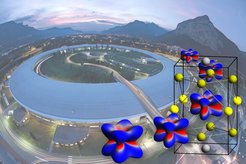Press Release: Are orbitals in magnetically ordering and superconducting compounds identical?
Cologne and Dresden physicist are investigating the successive change of orbitals with synchrotron based experiments.

The European synchrotron ESRF (European Synchrotron Radiation Facility) in Grenoble (France) is funded and operated by 21 countries so that scientists of the member countries can carry out their experiments at the forefront of modern science. Every year, several thousand scientists use this opportunity. The orbitals shown above were measured at ESRF and thanks to the high precision, small differences in the orbital shape could be detected.
The fascinating phenomenon of superconductivity, the conduction of currents without any losses, was already discovered in 1911 but only in the 1980ties the economical application became feasible after the discovery of the high-temperature copper oxide superconductors – triggering a boom in this field of research due to the technical relevance. Nevertheless, the detailed mechanism of high-temperature superconductivity is not yet understood, neither in the copper oxide nor Fe-pnictide high-temperature superconductors. It is believed though, that the interplay of magnetism and superconductivity is of central importance. This is astounding since conventional superconductivity and magnetism are mutually exclusive and one of the reasons why high-temperature superconductivity is called unconventional.
Here, the so called heavy fermion compounds enter the stage. They are conducting materials where the charge carriers move as if their mass were 1000 times heavier than the mass of the free electron. That is why they are called heavy fermions. Strong interactions of the electrons with one another are responsible for this mass enhancement. The heavy fermion phenomenon can be found in many solids containing cerium (Ce) or ytterbium (Yb). Many heavy fermion compounds also exhibit unconventional superconductivity, so that we may gain new inside into the mechanism of high-temperature superconductivity when we understand heavy fermion phase diagrams.
The heavy fermion family CeMIn5 with M = Co, Rh or Ir exhibit superconducting and magnetic ground states when substituting one M element for another and become even higher temperature superconductors when Ce is substituted by Pu. These materials are therefore recognized as important model systems in which a search for parameters, which go along with the formation of a magnetic or superconducting ground state, could be successful.
Such a parameter was identified in the substitution series CeRh1-xIrxIn5 by the group of Andrea Severing at the institute of Physics II from the University of Cologne in collaboration with scientists from the Max-Planck Institute for Chemical Physics of Solids in Dresden, the Los Alamos National Laboratory in the US and the Hiroshima University in Japan. The spatial distribution of the Ce electrons, i.e. the shape of the occupied orbitals, scales very sensitively with the respective ground state: Flatter orbitals correlate with magnetic order, while more extended orbitals occur in the superconducting compositions. The more extended orbitals can intermix (hybridize) more easily with other electrons and contribute therefore more to the electric conductivity. These observations are independent of lattice effects. Such a correlation had been theoretically suspected, but it was only now proven experimentally, thanks to polarized x-ray absorption measurements at the European Synchrotron Radiation Facility (ESRF) in Grenoble, France.
These observations yield a microscopic picture as a reply to the question when these materials become superconducting and hopefully stimulate further theoretical descriptions.
HR / CPfS
